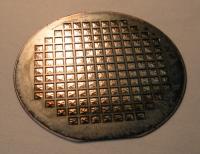Harvard School of Engineering and Applied Sciences (SEAS) material scientists and SiEnergy Systems have developed a macro-scale thin-film solid-oxide fuel cell (SOFC).
The research paper is published online on April 3 in Nature Nanotechnology, the discovery of this SOFC reveals that electrochemical fuel cells can be a viable clean energy source. The study was led by Shriram Ramanathan, associate professor of Materials Science at SEAS.
 SEAS Harvard's solid-oxide fuel cell membrane wafer
SEAS Harvard's solid-oxide fuel cell membrane wafer
Electrical energy was developed through an electrochemical response over a thin membrane. This 100nm membrane was made of electrolyte and electrodes, and is so thin that ions can pass through it at 300° C. to 500°C. This allows prompt start-up, a compact footprint, and limited use of rare-earth materials.
Chief author of the paper Masaru Tsuchiya, a former member of Ramanathan's lab who is now at SiEnergy and the team strengthened the thin film membrane with a metallic grid resembling nanoscale chicken wire. The metal honeycomb offers the structure for the membrane while collecting current. The team developed membrane chips that are 5mm wide. When multiplied by the large active area of this fuel cell, the power density forms an output source of power.
Source: http://www.seas.harvard.edu/